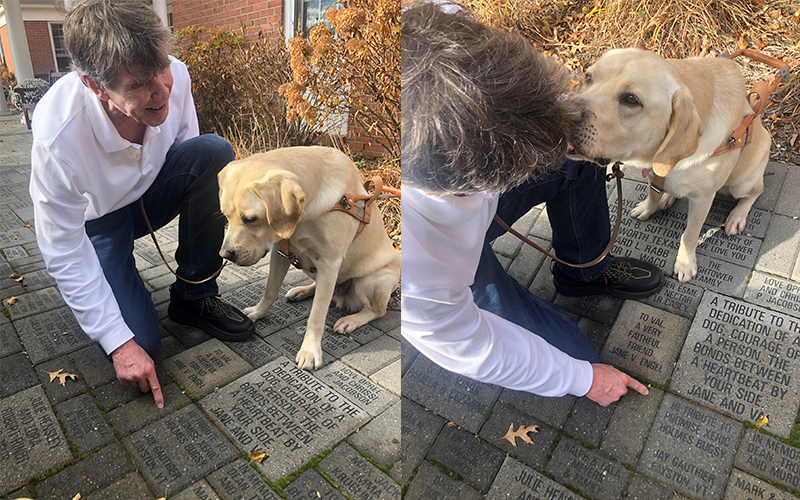Jay Gauthier and his current guide dog Pete are a familiar site on the sidewalks of Waitsfield. Gauthier is tall and strides along on long legs with Pete in the lead. Pete is his guide dog.
Pete, like his other dogs Promise, Xeric, Holmes and Bugsy, came from The Seeing Eye, in Morristown, New Jersey, the oldest guide dog training school in the world, Gauthier said.
Gauthier lost his sight in a car accident when he was 27 and having grown up in Massachusetts where he regularly encountered a woman with a guide dog, it was something he was interested in right away.
“When I lost my sight, I knew I wanted a seeing eye dog. I got a dog as soon as I was eligible,” he said.
SPENT FOUR WEEKS
He went to The Seeing Eye and spent four weeks in residence. He met one of the trainers and that trainer took Gauthier out for a walk, judging his pace, endurance, and stride. He was asked about his lifestyle, taught about how to use leash corrections and went through the process where trainers match 50-60 dogs to 24 blind people at a time.
“The trainers sit there and pow wow over how they think that matches should go between the people and the dogs,” Gauthier said, noting that The Seeing Eye breeds all of its dogs for guide dog work.
They breed about 500 dogs a year, a mix of labs, goldens and shepherds and those selecting dogs have their choice of breed.
Once partnered with a dog, Gauthier and his peers started working first with a trainer, and later solo with their dogs. As they progressed, the routes get more and more complex and get individualized.
In his case, he asked for and was trained on roads where there weren’t sidewalks as well as hiking trails.
WORK FOR EIGHT YEARS
Guide dogs usually work for eight years after training for two years. Ownership of the dogs is transferred to the vision-impaired person after training. Gauthier has always had a place for his dogs to go in retirement and he’s been able to see and visit the dogs occasionally over the years.
For folks who need help finding a home for their guide dog after it retires, The Seeing Eye will take them back and adopt them out with appropriate vetting.
“The decision on when to end their working career, is individual. I want to give them a chance to smell the roses. They have jobs and work hard and get stressed,” he said.
The relationship between a guide dog and its human is close and complex, Gauthier said.
ANTICIPATE EVERYTHING
“They anticipate everything. They’re very structured and I try to keep it that way, try to keep the routine consistent. A big thing for the dogs is the harness. They’re working when it’s on, whether they are lying at your feet or underway and guiding you. When the harness is off they relax, Gauthier said.
He said he doesn’t use the dog for moving around in his house, and lets Pete roam free in the house. Outside, in public, it can be challenging when people treat Pete like a companion dog and want to pet him and talk to him.
“It can be distracting for him. People see him, and use ‘doggy voices’ around him. Seeing Eye puts out information for the public encouraging them to avoid eye contract with a working guide dog in a harness, don’t talk to them, and to move around or away from them if possible,” Gauthier said.
DISTRACTIONS
He said with so many dogs allowed in so many places these days, there are more opportunities for Pete to get distracted.
“I don’t blame the other dogs and owners because Pete’s got distractions, that’s between us. It’s our issue,” Gauthier said.
Were Gauthier to find himself in a large public gathering where there were a lot of people and dogs, he’d take off Pete’s harness and let him be a dog, he said.
“But I’m always concerned about the public perceptions of leash corrections. Sometimes when we use leash corrections, you’ll hear a gasp from the public,” he said.
Leash corrections are how guide dogs are trained and their humans use them for their own safety.
“The dog is always on the left, and you put the leash through the index and middle finger and pick up the harness handle and give it a tug and snap the leash and use that word to give them a verbal connection,” he explained.
Gauthier walks with Pete for his own exercise as well as the dog’s. He does a lot of walking on Waitsfield’s sidewalks, frequently crossing Route 100 from Carroll Road. He approaches that crosswalk and often people waiting to turn into or out of Carroll Road wait for him, but he can’t see that and he is listening intently for the sound of tires.
MORE VERBAL COMMUNICATION
“Sometimes people are waving at me and flashing their lights. If people in the cars would roll down their windows to tell me they were waiting that would help. More verbal communication would be helpful,” he said.
He also said that when EV’s stop their engines stop and he has lost a clue that he needs to tell Pete it is okay to continue forward to cross the street.
“I’m super attuned to my surroundings. I stand there and focus and he waits for me to say ‘forward.’ We’re a team and he is not on auto-pilot. Guide dogs are taught intelligent disobedience. If he saw something coming, he’d back up,” Gauthier said.
In addition to walking in Waitsfield and beyond, Gauthier skis with Vermont Adaptive at Mount Ellen with his ski guides picking him up.













